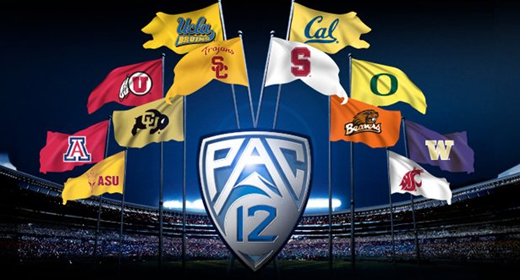Fighting for survival as vultures circle, the Pac-12 received a lifeline last week from an unlikely source: The SEC.
Mississippi State president Mark Keenum, chair of the College Football Playoff’s Board of Managers, worked with his fellow presidents to approve the expanded, 12-team format for the 2026 season, if not earlier.
While no direct credit was given, Keenum would not have pushed the Board forward without support from SEC commissioner Greg Sankey, who has long believed in the need for college football to thrive from coast to coast.
Yes, the move serves the SEC’s purposes by clearing a path for more members to participate in the sport’s biggest and most lucrative event. Same with the other behemoth, the Big Ten.
There are only 10 conferences. So long as the Pac-12 champ is ranked higher than its counterparts in the Sun Belt, Conference USA, Mid-American and either the Mountain West or American, a playoff berth awaits.
That is not a high bar.
Expansion effectively turns the Pac-12 championship into an early-round playoff game — and it has done the same for the title games in the ACC and Big 12.
As a result, the competitive component has taken on greater weight relative to the media revenue component within the broader realignment calculation.
Meanwhile, the Pac-12’s existential crisis has entered its third month. Until the Big Ten definitively ends its predation phase, the Pac-12 remains vulnerable to losing at least two and possibly four members (Washington, Oregon, Stanford and Cal) to the league that was once its peer and partner.
In that scenario, Arizona, Arizona State, Colorado and Utah would undoubtedly bolt for the Big 12 and, as we explained previously in a look at the future of the Power Five, the 107-year-old bastion of college sports on the West Coast would dissolve.
Our view remains unchanged: Pac-12 survival is a slight favorite over Pac-12 extinction. The most likely outcome calls for the 10 schools to unify around a medium-term media rights contract.
And if that’s the case … if the 10 schools coalesce … they should incorporate the reality of a 12-team playoff field into its strategic initiatives.
The conference was passive last summer, opting against expansion as the Big 12 teetered following the loss of Texas and Oklahoma to the SEC.
This time, the Pac-12 should take the lifeline tossed by the CFP presidents and adopt a more Machiavellian approach.
It should consider kneecapping the Mountain West and getting creative with membership in both major sports.
Here are three scenarios we believe the Pac-12 should pursue:
— Add San Diego State and either Fresno State or Boise State as either full-time or football-only members.
Why? Because those are the best programs in the MW.
In addition, SDSU brings the San Diego media market (No. 27 nationally) and a crucial foothold in the Pac-12’s most important recruiting region. Also, admission to the Pac-12 would keep the Aztecs out of the Big 12, which has designs on the West Coast.
Fresno State sits on the outskirts of the huge Sacramento media market (No. 20) and brings a rabid following in California’s heavily-populated Central Valley.
Boise State doesn’t fit the Pac-12 model in any form, except for its football success.
— Add San Diego State, Boise State and Fresno State in all sports and SMU as a football-only member.
Why? Because SMU would expand the Pac-12 footprint into the Dallas media market and strengthen the recruiting pipeline to the Lone Star State.
The school is No. 68 in the U.S. News and World Report rankings — ahead of every continuing Pac-12 university except Stanford, Cal and Washington — and owns a substantial endowment ($2 billion).
Also, the Mustangs recently unveiled a NIL program that compares favorably to any in the Pac-12.
No, they weren’t invited to the Big 12 — we presume Baylor and TCU blocked the move, wanting no part of an enhanced competitor in Dallas — but institutionally, the school fits better into the Pac-12 (or ACC) than it does the Big 12.
— Add San Diego State, Boise State and Fresno State in all sports, SMU as a football-only member, and Gonzaga as a basketball-only member.
Why? Because Gonzaga would instantly elevate the depleted Pac-12 basketball product and satisfy Arizona’s need for a second powerhouse. The Zags are the best possible replacement for UCLA among schools that aren’t currently members of the Power Five. (Hello, Kansas.)
Now, let’s outline the reasoning for our approach:
1. The competitive piece.
Grabbing San Diego State and Boise State, and perhaps Fresno State, would render the Mountain West obsolete in the new CFP format.
The winner of that diminished conference would have little chance of claiming one of the six automatic bids, hence solidifying the Pac-12 champion’s status as a playoff participant and further enhancing the value of its regular season.
2. The inventory piece.
More teams equate to more games and more content to offer network partners as the Pac-12 negotiates its next media contract.
With 12 or 14 teams in football, the Pac-12 could play late games on Thursday, Friday and Saturday nights.
Three games per week over 13 weeks is 39 games (math!). At 3.5 hours per broadcast, that’s almost 140 programming hours in prime time, with little-to-no competition, for the 75 million people in the Mountain and Pacific Time Zones, plus interested fans in the eastern half of the country.
The Pac-12 can’t fill those windows without the inventory; it can’t provide the inventory without the games; and it can’t schedule the games without the teams.
3. The revenue piece.
Pac-12 schools already have trouble providing their football teams with the necessary resources compared to peers in the Big Ten and SEC. They certainly wouldn’t approve an expansion plan that undercuts new revenue by any significant amount.
But they won’t need to.
Mountain West schools currently receive roughly $4 million annually from the league’s deal with CBS and Fox. If offered membership to the Pac-12, they would happily accept reduced shares over the lifetime of the next contract cycle.
There is strength in numbers, and there are ways to increase numbers without decreasing the revenue shares for your premier programs.
Granted, the addition of quality teams from the Mountain West would increase competition for Pac-12 schools with designs on regular playoff bids.
Our view is the benefits of expansion — diminishing the Mountain West and enhancing the football inventory while not squeezing revenue — would offset the increased intra-conference competition.
It’s not like the Pac-12 would be adding USC.
As we saw with Utah, it takes time for successful football programs in the Mountain West to build the talent and depth needed to thrive in the Pac-12.
The conference could have expanded last summer. It could have added Houston or SMU. It could have decimated the Big 12, deploying the same strategy the Big 12 is now attempting to use against the Pac-12.
But the conference held off because the money wasn’t ideal and the institutional fits weren’t right.
Then it took a knife to the gut, courtesy of its Rose Bowl partner, and is fighting for life.
The CFP presidents have offered a chance for the Pac-12 to turn back the clock and execute on the expansion opportunity it declined last summer.
What was it that Einstein said about insanity?
Previously in this series:
Our vision for the future of the Pac-12 and Power Five
Support the Hotline: Receive three months of unlimited access for just 99 cents. Yep, that’s 99 cents for 90 days, with the option to cancel anytime. Details are here, and thanks for your support.
*** Send suggestions, comments and tips (confidentiality guaranteed) to pac12hotline@bayareanewsgroup.com or call 408-920-5716
*** Follow me on Twitter: @WilnerHotline
*** Pac-12 Hotline is not endorsed or sponsored by the Pac-12 Conference, and the views expressed herein do not necessarily reflect the views of the Conference.
Related posts:
 Wilner Hotline – Pac-12 Mailbag, Big Miss on Arizona Basketball, More
Wilner Hotline – Pac-12 Mailbag, Big Miss on Arizona Basketball, More  VIDEO – Jon Wilner and Brad on Pac-12 next steps
VIDEO – Jon Wilner and Brad on Pac-12 next steps  Kliavkoff says Big 12 “scared,” UCLA in tough spot with Big Ten move, Pac-12 exploring expansion and big tech interested in media rights
Kliavkoff says Big 12 “scared,” UCLA in tough spot with Big Ten move, Pac-12 exploring expansion and big tech interested in media rights 
(AP Photo/Ralph Freso, File)
Pac-12 survival: Kliavkoff on media rights timeline, Big 12 and Big Ten threats, playoff expansion and UCLA’s move
